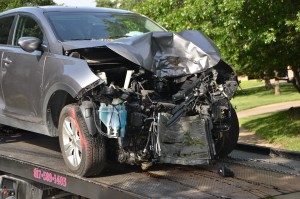 In honour of February being Aggressive Driving Awareness month, we’re presenting a brief comparison between aggressive and defensive driving. Along with offering our readers a few truths and tips, we hope to raise awareness of the very real danger of driving aggressively.
In honour of February being Aggressive Driving Awareness month, we’re presenting a brief comparison between aggressive and defensive driving. Along with offering our readers a few truths and tips, we hope to raise awareness of the very real danger of driving aggressively.
Aggressive vs. Defensive- The Breakdown
First, let’s examine the language and take a look at some definitions. According to Google, the word ‘aggressive’ is defined as “ready or likely to attack or confront; characterized by or resulting from aggression,” and “pursuing one’s aims and interests forcefully, sometimes unduly so.” Some synonyms include ‘pushy’, ‘hostile’, ‘belligerent’, and ‘forceful.’ Not exactly the picture of an ideal driver, is it? Examples of actions categorized as aggressive include tailgating; cutting off other drivers; yelling at, swearing at, or rudely gesturing at others on the road; speeding and weaving in and out of traffic; driving in such a way as to intimidate others or incite violence; distracted driving (texting, loud music, reading the paper), etc. The list really is endless, which says as much about our creativity as it unfortunately does of our anger management issues!
Next, we’ll examine the term ‘defensive.’ The Google definition reads as follows: “used or intended to defend or protect,” and the synonym given in this case is ‘protective.’ Include ‘driving’ in the search, and the description is even more precise. The U.S. National Safety Council defines ‘defensive driving’ as “driving to save lives, time, and money, in spite of the conditions around you and the actions of others.” Driving defensively also means following the rules set out by the Ministry of Transportation, and looks like the skills taught in Driver’s Education* classes. Ensuring the way is clear before entering the line of traffic; signaling and checking blind spots; allowing others to merge; following and obeying posted signs and speed limits; keeping a safe distance between your vehicle and other drivers; staying calm when it seems like other drivers are doing everything possible to make your drive terrible. The rules of the road aren’t simply a suggestion; defensive driving is designed to keep everyone safe on the road, ourselves included.
The Facts
For those who remain unconvinced of the perils of aggressive driving, here’s an actual statistic to digest. Our neighbours down South recently released a study by the National Highway Traffic Safety Administration, reporting that 66% of road fatalities are a direct result of some form of aggressive driving.
66 out of every one hundred fatalities.
These accidents were not related to inclement weather, or vehicle malfunction, or even human error. Instead, more than half of all motor vehicle deaths in the U.S. were entirely caused by people choosing to drive aggressively.
Allow the reality of that statement sink in. It’s difficult to comprehend how someone could make a conscious choice to commit an action that is likely to cause harm, or even death, to a fellow human being. In all honesty, it’s pretty shocking to realize that 100% of those deaths were actually preventable, meaning 66% of all traffic-related deaths in the U.S. did not have to happen.
Canada’s comparable numbers are just as disturbing. According to reports from Transport Canada, 27% of Canadian road fatalities are a direct result of speeding, while 40% of intersection fatalities are due to drivers disobeying traffic signals and failing to yield the right of way. Each of these deaths was caused by an entirely preventable accident, and each death resulted in completely avoidable heartache.
The Choice is Yours
Despite what some drivers believe, aggressive driving is not a requirement for owning a vehicle, being a commuter, or driving for a living. It is not a necessary part of living in a city, being stuck in traffic, or dealing with other drivers. Not even the really bad ones. What aggressive driving is, however, is a choice, and every driver must choose. It’s a choice that presents itself over and over; every time we get cut off; every time we see another driver weaving through traffic without a signal; every time we get behind the wheel. Some days it’s an incredibly difficult choice, but it’s still ours to make.
Defensive driving is every driver’s choice as well. While sometimes it seems like the road less travelled, and even feels against our nature, it is the best choice we can make for everyone who shares the road. Being a defensive driver means choosing to take a deep breath and ignore the urge to tailgate the car doing 40 in a 60 km/h zone. It’s choosing to make sure there is enough space between you and the surrounding vehicles so you can safely stop should the need suddenly arise. It’s choosing not to retaliate when another driver flips you off because you didn’t race through the yellow light when it wasn’t clear. It’s a choice to be responsible for the safety of everyone in your vehicle, and every other vehicle on the road.
Upon review, it becomes painfully obvious that there is one clear winner when comparing an aggressive driver to a defensive one. Frankly, no argument could defeat “driving to save lives” as the better option between the two. Talk about a dose of much-needed perspective. It’s often a hard choice, but it’s always the best one. It’s a choice every driver must face, and the result is too important to ignore.
*Driver’s Education classes are always a good idea for new drivers, and could get you a discount on your insurance. Contact your broker for details.
